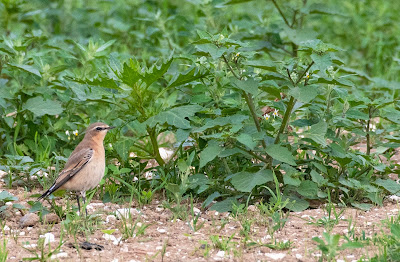At the end of my last post, I nearly wrote of my
anticipation for August. It’s a month that always delivers locally, despite being
somewhat maligned by birders. This is probably because of the post-breeding
dispersal factor that is far more noticeable inland than it would be at a
wetland or coastal site. Anyway, in fear of jinxing it, I didn’t write about
said anticipation – it seems that was wise, with the first few days already
providing some excellent birding.
 |
| Swallows, Tilsey Farm, 3/8/2019. |
Allden’s Hill has been the focal point. On Friday, I combined
collecting the microphone with an hour or so of sky-watching. There were a few Woodpigeons
and Stock Doves darting about at sunrise, in no real pattern. Then, at 05:41, I clocked a
Turtle Dove heading towards me, as it flicked and dashed north-east. It was
gone in a flash, but it goes without saying I was delighted to witness this rapidly
declining gem grace my patch.
The species is just about annual here (one in 2015, two in
2016, 0 in 2017 and one in 2018) though they are almost always flyovers. Turtle
Dove has never been common in Surrey during my lifetime. Nowadays they are practically
extinct, save one site close to the West Sussex border (only a couple of miles
from my patch as the dove flies) where a pair present last year was followed
up by a singing male this year. Just over said border the population is far
healthier, increasing slightly as one heads south and east to the modern-day
hot-spot (best site in Britain?) of Knepp.
 |
| Red Kite, Tilsey Farm, 3/8/2019. |
 |
| Painted Lady, New Barn, 4/8/2019. |
This record would normally make a weekend, but it was eclipsed by a noc-mig whopper picked up in the small hours of Sunday morning.
This
Stone-curlew was most surprising and apparent reward for a largely poor year
of nocturnal recording. The tones are pretty classic and distinctive, the sonogram
looks good and the consensus from those I consulted was instantly
Stone-curlew. However, it is a slightly atypical call – when I get the time I’ll
do some thorough research before formally submitting it.
 |
| Stone-curlew sonogram. |
Following a huge decline and range contraction in the late
1800s/early 1900s, Stone-curlew has increased since the turn of the millennium, reflected in the number of Surrey records. It is almost annual nowadays,
though notoriously hard to twitch in the county. The nearest breeding birds are
in Sussex, though a far healthier population persists in Wiltshire. There seems
to be some sort of passage going on at present, with Dawlish Warren and Prawle
Point logging extralimital birds over the weekend.
However, despite being easily the second rarest noc-mig
record I’ve been lucky enough to log, it’s actually something that could conceivable
turn up at Thorncombe Street one day. Indeed, I’ve daydreamed before about finding
one stood in one of the sheep fields one early April morning. The species bred
on the North Downs at Compton until the 1800s but, despite the increase in Surrey
records in the modern-day, Stone-curlew remains a south-west Surrey mega – the last was at
Thursley Common in 1995 (also in August), while the one before that was at Shalford Water
Meadows during the Second World War.
 |
| Wheatear, Bonhurst Farm, 4/8/2019. |
There were plenty of other signs of autumn on patch over the weekend. On Saturday, the first juvenile
Willow Warbler of the season (appallingly only the
third of 2019) was at Selhurst Common, while a typically charming
female-type
Wheatear was a notably early individual at Bonhurst Farm on Sunday. A flock
of 73, mainly juvenile,
Starlings at the same site whiffed of summers' close, as
did a
Siskin or two at Scotsland Brook (though this species seems to have bred
at Hascombe Hill this year).
 |
| Wheatear, Bonhurst Farm, 4/8/2019. |
The first
Lesser Black-backed Gull of autumn was yet
another hint of change, while the appearance of
Spotted Flycatchers in random places
befitted the season, even if it seems they had a difficult breeding campaign following random days of heavy rain during June and July. Away from patch, a distant
Common Sandpiper at a private site was a final local flavour of the month.
 |
| Common Sandpiper, south-west Surrey, 4/8/2019. |
Despite all the above, I still had time to dust off my
twitching boots and head to good old Pagham for the finally reappearing (and staying
put) Squacco Heron. A ninth for Sussex, it's the second for the Selsey peninsula, following one on 19 June 1995. This was my first twitch since the Grey Catbird in Cornwall
last October, with the one before that over a year ago also at Pagham, for
the American Royal Tern). My twitching game outside of Surrey is pretty shocking to be honest.
As many previous posts will have proclaimed, I love Pagham
Harbour, and Saturday afternoon was one of those classic trips during which
there was plenty to see. Aside from the somewhat frustratingly brief Squacco at
Halsey’s Farm, I also saw a host of waders including
Wood Sandpiper and
Spotted
Redshank, along with two
Cattle Egrets and a
Yellow-legged Gull.
 |
| Squacco Heron, Halsey's Farm, Sidlesham, 3/8/2019. |
In all, a memorable weekend of largely local August birding. Hopefully
there’s plenty more to come in the weeks ahead.











No comments:
Post a Comment